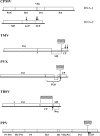Use of viral vectors for vaccine production in plants
- PMID: 15877604
- PMCID: PMC7165799
- DOI: 10.1111/j.1440-1711.2005.01339.x
Use of viral vectors for vaccine production in plants
Abstract
The small size of plant viral genomes, the ease with which they can be manipulated, and the simplicity of the infection process is making the viral vectors an attractive alternative to the transgenic systems for the expression of foreign proteins in plants. One use of these virus expression systems is for vaccine production. There are two basic types of viral system that have been developed for the production of immunogenic peptides and proteins in plants: epitope presentation and polypeptide expression systems. In this review, we discuss advances made in this field.
Figures

Similar articles
-
Making an ally from an enemy: plant virology and the new agriculture.Annu Rev Phytopathol. 2002;40:45-74. doi: 10.1146/annurev.phyto.40.021102.150133. Epub 2002 Feb 20. Annu Rev Phytopathol. 2002. PMID: 12147754 Review.
-
Vaccines by agriculture.Mol Med Today. 1996 Jul;2(7):278-81. doi: 10.1016/1357-4310(96)20020-6. Mol Med Today. 1996. PMID: 8796907
-
Plant virus expression vectors set the stage as production platforms for biopharmaceutical proteins.Virology. 2012 Nov 10;433(1):1-6. doi: 10.1016/j.virol.2012.06.012. Virology. 2012. PMID: 22979981 Review.
-
Expression in plants and immunogenicity of plant virus-based experimental rabies vaccine.Vaccine. 2002 Aug 19;20(25-26):3155-64. doi: 10.1016/s0264-410x(02)00260-8. Vaccine. 2002. PMID: 12163267
-
Development of cowpea mosaic virus-based vectors for the production of vaccines in plants.Expert Rev Vaccines. 2005 Oct;4(5):687-97. doi: 10.1586/14760584.4.5.687. Expert Rev Vaccines. 2005. PMID: 16221070 Review.
Cited by
-
A novel system for rapid and cost-effective production of detection and diagnostic reagents of West Nile virus in plants.J Biomed Biotechnol. 2012;2012:106783. doi: 10.1155/2012/106783. Epub 2011 Dec 4. J Biomed Biotechnol. 2012. PMID: 22187532 Free PMC article.
-
Virus-like particles: the new frontier of vaccines for animal viral infections.Vet Immunol Immunopathol. 2012 Aug 15;148(3-4):211-25. doi: 10.1016/j.vetimm.2012.04.026. Epub 2012 Jun 1. Vet Immunol Immunopathol. 2012. PMID: 22705417 Free PMC article. Review.
-
Proteasome-independent major histocompatibility complex class I cross-presentation mediated by papaya mosaic virus-like particles leads to expansion of specific human T cells.J Virol. 2007 Feb;81(3):1319-26. doi: 10.1128/JVI.01720-06. Epub 2006 Nov 22. J Virol. 2007. PMID: 17121795 Free PMC article.
-
Constraints to virus infection in Nicotiana benthamiana plants transformed with a potyvirus amplicon.BMC Plant Biol. 2010 Jul 6;10:139. doi: 10.1186/1471-2229-10-139. BMC Plant Biol. 2010. PMID: 20604920 Free PMC article.
-
The pEAQ vector series: the easy and quick way to produce recombinant proteins in plants.Plant Mol Biol. 2013 Sep;83(1-2):51-8. doi: 10.1007/s11103-013-0036-1. Epub 2013 Mar 12. Plant Mol Biol. 2013. PMID: 23479085 Review.
References
-
- Porta C, Lomonossoff GP. Use of viral replicons for the expression of genes in plants. Mol. Biotechnol. 1996; 5: 209–21. - PubMed
-
- Porta C, Lomonossoff GP. Viruses as vectors for the expression of foreign sequences in plants. Biotechnol. Genet. Eng. Rev. 2002; 19: 245–91. - PubMed
-
- Siegel A. RNA viruses as cloning vehicles. Phytopathology 1983; 73: 775.
-
- Scholthof HB, Scholthof KB, Jackson AO. Plant virus gene vectors for transient expression of foreign proteins in plants. Annu. Rev. Phytopathol. 1996; 34: 299–323. - PubMed
Publication types
MeSH terms
Substances
LinkOut - more resources
Full Text Sources
Other Literature Sources

